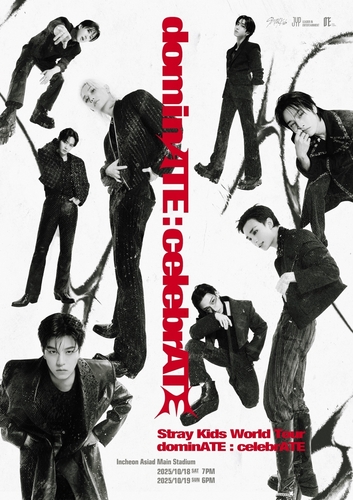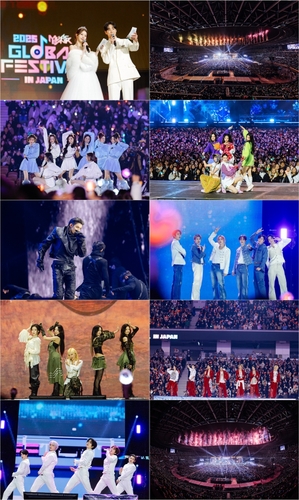Golden Girls set off to prove age is just a number, even in K-pop

In the K-pop music world, there exists an unwritten yet widely practiced rule: Unless you are young and pretty, you won't steal the limelight.
But this is slowly beginning to change, with some veteran female singers in their 40s, 50s and even 60s returning to prime-time TV shows and challenging themselves in new areas.
Most recently, singer Lee Hyo-ri appeared as a host for a late-night music show titled “The Seasons: Lee Hyo-ri’s Red Carpet,” at 44 years old. Jennie, a member of girl group Blackpink, showed up as the first guest to congratulate Lee. The two did their own version of rapper Cardi B’s "WAP" dance, which went viral on social media. The two's encounter was the talk of the town not only because it was a meeting of one of the hottest singers of today and Lee, part of the first-generation girl groups, but also because it was the first time for Jennie to appear on KBS since debuting in 2016.
In another TV show, “Golden Girls,” diva Lee Eun-mi sang “See Through” by rapper Primary, clad in an off-shoulder dress with a slit on one side. The 57-year-old singer has long been described as Joan of Arc on the stage, with her charismatic stage manner and coarse, soulful voice, but it was the first time Lee presented such a sultry performance as a member of Golden Girls.
Golden Girls is the result of efforts from singer-producer Park Jin-young, who also produced top K-pop acts such as ITZY and Twice. Members' average age in Golden Girls is 59.5 years, but Park said he would market the group just like any other current-day fifth-generation girl group, like NewJeans or IVE.
The show revolves around veteran female singers Insooni, Lee Eun-mi, Shin Hyo-bum and Park Mi-kyung, and spotlights the tough training they have to go through until their debut day. The four singers finally released a debut single titled “One Last Time” late last year, which received much love.
The four Golden Girls members got to enjoy a second heyday. They threw fan meet events, held surprise free concerts on the street, and even won the Rookie of the Year award at KBS. The group recently released its second single “The Moment,” highly influenced by 1960s swing jazz.
Nobody expected to see such a dramatic transformation of the singers, who had stuck to their distinctive styles over the past 30 or 40 years. To make this all a reality, they lived together under the same roof, just like today’s K-pop groups do, and took vocal and dance lessons. The journey of the seasoned singers, following them until they become Golden Girls, is empowering in that it shows people that age is nothing but a number. The advent of Golden Girls also signals the changes underway in the country’s music industry.
Instead of singing their old hit songs and relying on their fame, their potential is being tested to see whether they can still be marketable as trendsetters in the music market.
The return of the older ladies to the music scene first started gaining traction with Lee Hyo-ri last year. She came up with the idea of putting together female dance singers of the 1990s and 2000s, who ruled the market at the time, and they hit the road and jumped in a van to perform here and there across the country. The TV show titled “Dancing Queens on the Road” was produced by star producer Kim Tae-ho.
Some criticized the show for capitalizing on the nostalgia of music fans, but the cast of the TV show such as Kim Wan-seon and Uhm Jung-hwa, both in their 50s, succeeded in making names for themselves to younger listeners who were less familiar with them. It was a high-level marketing strategy.

In reality, few recording companies are willing to produce albums of female singers in their late 30s and 40s. Well aware of this, the singers who appeared in “Dancing Queens on the Road” gave their all wherever they performed. They once staged a performance in the parking lot of a small fire station, and sang and danced at a small taekwondo event for children.
After the show was put on air, Lee made a surprise announcement saying that she would star in commercial advertisements last July. Right after the announcement, she signed decades worth of endorsement deals. The singer, who is an animal rights advocate, had said in 2011 that she would not be part of commercials because they were against her values. Lee also released a single titled “Hoodie E Banbaji,” her first in six years, in October last year.
Kim and Uhm’s solo concerts after their appearance in “Dancing Queens on the Road" also sold well.
But it is still hard to say the show expanded the scope of career possibilities for female singers in their 40s and 50s. On the show, the singers mostly did what they did in the past instead of trying their hand at something new.
The “Golden Girls” show is somewhat different from “Dancing Queens on the Road.” Singers aged between 57 and 66 are trained using the same system as is used for current K-pop groups. At first, the singers thought they were too old to be dubbed a girl group — they rather preferred to name themselves a grandma group. But seeing them moving their hips for the choreography of Sistar’s “Touch My Body” or lying on the floor and showing off their legs for Miss A’s “Goodbye Baby,” viewers find themselves rooting for their cause.

There has been a rigid standard for women who appear on TV shows: They should be young and beautiful. But TV show “Street Woman Fighter” also brought a change by featuring girl-next-door types of female dancers to the forefront. “Golden Girls” similarly breaks stereotypes that older ladies should be elegant.
It is also meaningful that singer-producer Park embarks on this journey not at his entertainment company but at KBS, a public broadcasting station. He composed new songs for Golden Girls and even made up the nickname for the group’s fans: Gorgeous.
Culture critic Lee Young-mi said, “What sets ‘Golden Girls’ apart from other similar shows is the involvement of Park. As he participated in the show, the scale and boundary of the show became a lot bigger.
“Like how ‘Mr. Trot’ discovered obscure trot musicians working at nightclubs and helped them find new market avenues such as concerts for themselves, Park produced the show by targeting untapped music fans. It was very strategic,” Lee added.
Park said in a press release, “It was my idea to make a girl group with these singers. I wanted to bring diversity to the music industry by introducing an older generation of artists.”
It is still uncertain whether Golden Girls has brought changes to the music industry as Park wished.
Culture critic Lee said, “The show was nothing but a reality show with a heavy focus on the challenges and hardships of the singers. So it’s hard to say it has brought any sort of sustainable change to the music scene.
“There needs to be a sequel to the show. When the sequel gives chances to other singers who performed in the same periods, we can say the show contributed to making a new ecosystem in the music scene,” Lee added.
Cho Ji-seon, a visiting professor of psychology at Yonsei University, said Golden Girls made us think of diversity and inclusion, which are the two biggest issues society has been dealing with recently.
“The older generation [of singers] tries to follow the new trend and overcomes the generation gap by doing so. They also shatter the stereotypes people have about old female singers.
“There is even a study saying that people stop listening to new songs when they are over 30. Both singers and listeners refrain from making diverse choices as they grow older, but we live in a time when diversity is more important than ever. If we could congratulate them on the things Golden Girls has achieved and accept their new styles, we will have more flexibility not only in music but in other areas of society,” Cho added.
BY YOO JU-HYUN [kjdculture@joognang.co.kr]



